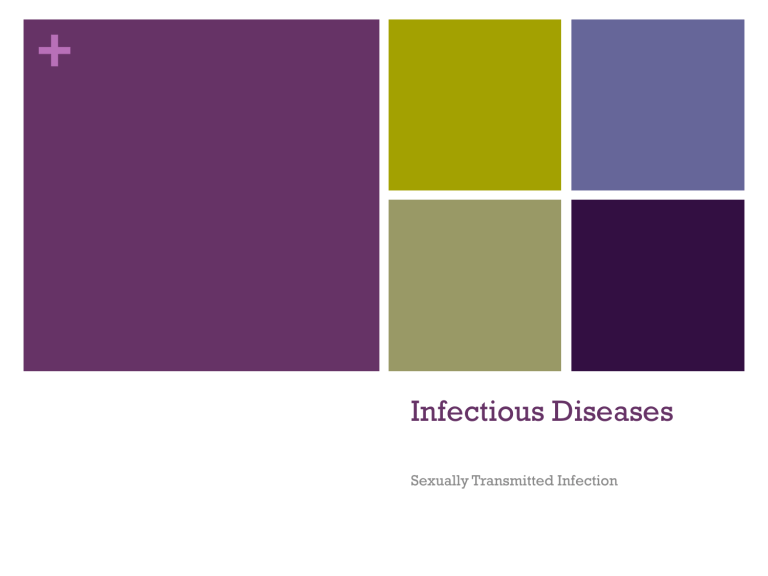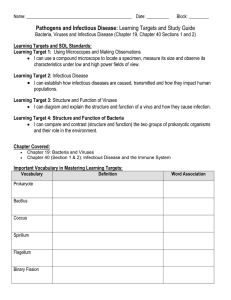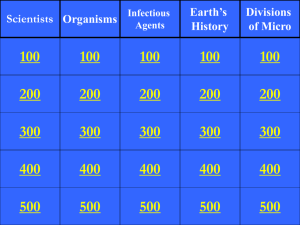Infectious Diseases - bloodhounds Incorporated

+
Infectious Diseases
Sexually Transmitted Infection
+
What is a Disease?
Disease = Any interference with the normal functioning of the body organs or systems
Human Disease may be caused by
Environmental factors
Defects of body structures or functions
Activities of infectious microorganisms
+
Signs, Symptoms and Syndromes
Signs
A more or less observable and obvious feature of a disease
Includes things like diarrhia, a rash, peeling of the skin
Painless lesion of syphilis called a chancre
Symptom
Any change in a body structure of function that can be observed or felt by the individual
Asymptomatic
+
Signs, Symptoms and Syndromes
Syndrome
A combination of signs and symptoms occurring in a typical pattern
Etiology
The cause, set of causes, or manner of causation of a disease or condition
Sequelae
Some diseases leave aftereffects
Viral infections of the liver can result in the loss of functioning liver cells and interference with bloodflow through the organ
+
Signs, Symptoms and Syndromes
The outcome of a disease depends on
Genetics
Age
Nutritional status
Prior exposure to the infectious agent
Resulting levels of body protection or immunity
Prognosis
Predict the course and outcome of a disease
+
Types of Diseases
Diseases can be placed in descriptive groups:
Hereditary and congenital
Degenerative
Neoplastic
Metabolic
Immunological infectious
+
Hereditary and Congenital
Diseases
Hereditary Diseases
Caused by errors in the information present in an abnormal gene or genes
May be abnormalities in
The number and distribution of chromosomes
Interaction of genetic and environmental factors
Down’s Syndrome
Abnormal distribution of chromosomes
Trisomy 21
+
Hereditary and Congenital
Diseases
Abnormalities that develop between the time of fertilization
(conception) and birth are divided into two categories
Embryonic Period
First eight weeks of pregnancy
Fetal Period
From the ninth week of pregnancy to birth
+
Embryonic Period
Changes occurring produce visible deformities of organs or other body structures
Embryonic or congenital defects
Are present at birth
Drugs, excessive X-ray exposure, or certain infections may disrupt the developing embryo or fetus
The embryo is most vulnerable to injury during the 3 rd to 8 th week of pregnancy
Infections acquired by the mother may injure the developing fetus and cause congenital defects
Mental retardation, blindness, brain injury, even death
German measles (rubella), Syphilis, Genital Herpes
+
Degenerative Diseases
The breakdown of various body parts
Aging
Chronic (long lasting) illnesses that can lead to death
Heart attack
Stroke (bleeding and/or blockages in blood vessels of the brain)
Could occur even without aging
Hardening of the arteries
Certain forms of arthritis
Degenerating joints
Diverticulitis
+
Neoplastic Diseases
Diseases associated with abnormal cell growth that leads to the formation of various types of tumors
Benign (harmless)
Malignant (cancerous)
One in five persons die in the United States of some form of cancer
Human papilloma viruses cause genital warts
Has been associated with cervical cancer
+
Metabolic Diseases
These diseases include a variety of disorders in which the body’s production of chemical products essential to its functioning either are nonexistent or defective
Hormones
A chemical product body a body organ or gland, which is carried by the blood to another body site where it stimulates a particular function
Endocrine
Enzymes
A complex proteins produced by cells, that causes changes in other substances without being changed in the process
+
Immunologic Diseases
Diseases that result from the improper or impaired functioning of the body’s immune system
The immune system provides protection against various disease agents and other factors in an individual’s environment
The immune system can destroy or neutralize disease agents and factors considered to be foreign by the immune system
Inflammation
A response to tissue injury
Swelling, redness, local heat, pain, and abnormal functionin of the part involved
+
Immunologic Diseases
Immunologic diseases are grouped into two categories:
Primary Immunodeficiencies
Arise from an inherited lack of development of one or more parts of the immune system
Secondary Immunodeficiencies
Occur more frequently than primary
Results from many factors that suppress an individual’s immune responses to events such as infection
AIDS
+
Infectious Diseases
Microbiota
Microscopic forms that live on the skin, in the mouth and the large intestine
Most are harmless
Some, if given the opportunity can cause a disease
These are known as opportunists
Can lead to opportunistic infections
Pathogens
Microorganisms that cause severe problems upon gaining entrance to the host tissues
Pathogenesis
Eventual development of a diseases
+
Infectious Diseases
Pathogenicity
The disease producing capability of a pathogen
Virulence
The degree or intensity of pathogenicity
Infectious Diseases are caused by infectious agents
Bacteria
Fungi
Protozoa
Viruses
Helminths (worms)
+
Infectious Diseases
Communicable or Contagious
Certain infectious diseases can spread from person to person
Flu or measles
Gonorrhea or syphilis
Noncommunicable or not contagious
Caused by an infectious agent but does not spread from person to person
Tetanus
+
The Course of an Infectious
Disease
Incubation Period
The time between the multiplication of the pathogen and the appearance of signs and symptoms
Prodromal Phase
The early stage of some diseases in which nonspecific symptoms such as headache and general weakness appear
+
The Course of an Infectious
Disease
Invasive Phase
The period during which pathogens invade and cause tissue damage
Signs and symptoms of the disease appear at the same time
Convalescence Phase
The time period during which recovery occurs and includes healing and regaining strength
Even if signs and symptoms disappear individuals may still be able to spread an infectious diseases
+
The Course of an Infectious
Disease
Acute
Disease occurs rapidly and sometimes with intense symptoms
Chronic
Disease develops more slowly and lasts for a longer, indefinite, period of time
+
The Concept of Infectious Disease
Girolamo Fracastorius , a Franciscan monk in 1546
Distinguished several ways an infectious disease was able to spread
Contact with the skin
Contact with objects close to a sick person
The air in a sickroom
Anton Van Leeuwenhoek, late 1600s
Created the first real microscope
Discovered microorganisms with his microscope
Rober Koch1876
Koch’s Postulate - “Germ theory of disease”
Demonstrated a specific bacterium caused anthrax
+
Factors Contributing to the Success of an Infectious Disease
Pathogens act in certain ways to cause diseases
Gaining access to the host
Attaching to and reproducing on the cell surface
Invading body tissues
Producing poisonous substances known as toxins to breakdown the body’s defenses
Toxins may also cause allergic responses in some people
+
The Microbial World
Bacteria
Single-celled microorganisms
May be beneficial or harmful to the host
Bacteria are differentiated from one another by several factors:
Shape
Color reactions
Chemical composition
Growth
Responses to chemicals such as antibiotics
+
Shape of Bacteria
Coccus
Spherical form
Bacillus
Rod
Spirillum
Twisted or bent
Tight corkscrew known as a spirochete
+
Coccus Bacillus
+
Isolating and Growing (Culturing)
Bacteria
Medium –
Nutrient used to grow bacteria
Made from broth or liquid, and solid or agar
Contains nutrients
Sugar
Protein
Vitamins
Minerals
+
Fungi
Fungi
Single- and multi-cellular forms of life
Yeast
Molds
Mushrooms
The majority of fungi are involved natural decomposition of rotting and decaying plant and related material
Commercial production of some bakery goods, cheeses, antibiotics, alcoholic beverages and other chemicals
Some fungi can attack the
Skin, nails and hair
Causes different forms of ringworm
Athlete’s foot
Some can form STD’s like a yeast infection
Fungi are opportunistic
+
Fungi
+
Protozoa
Single-celled animal-like microorganisms
Most are harmless and found in the soil and water
Some causes diseases such as malaria, African sleeping sickness and Amebic dysentery
Protozoa are opportunistic and cause STD’s
+
Viruses
Cannot be seen by an ordinary light microscope
Must use an electron microscope
Viruses are therefore called submicroscopic
Chicken pox
HIV
Viruses are not cells
Viruses vary in shape
+
Viruses
Virions
Individual virus particles
Contain a single type of nucleic acid
Either DNA or RNA but never both
Capsid
Protein coat encloses the nucleic acid component
Culvitation
Viruses can only replicate in living cells
+
Helminths or Worms
Helminths that cause most of human disease are
Flatworms
Roundworms







